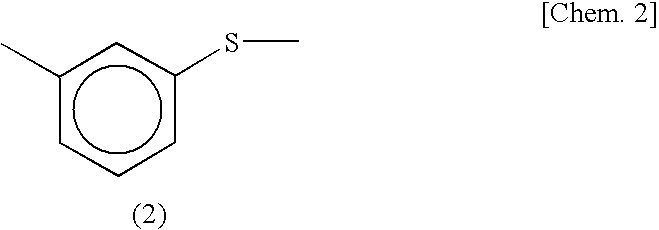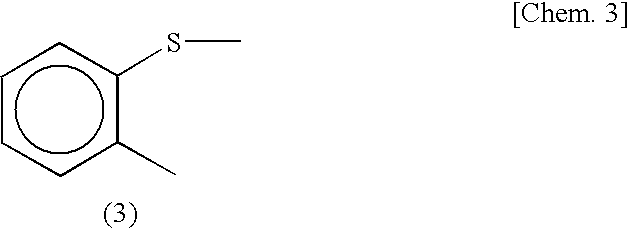Polyarylene sulfide composition
a polyarylene sulfide and composition technology, applied in the field of polyarylene sulfide composition, can solve the problems of insufficient dimensional stability, large thermal expansion, and thermal conductivity, and achieve excellent thermal conductivity, dimensional stability, and heat resistance.
- Summary
- Abstract
- Description
- Claims
- Application Information
AI Technical Summary
Benefits of technology
Problems solved by technology
Method used
Image
Examples
synthesis example 1
Synthesis of PPS (a-1) and PPS (a-2)
[0067]1,866 g of Na2S.2.8H2O and 5 liters of N-methyl-2-pyrrolidone (hereinafter referred to as “NMP”) were charged in 15 liters autoclave equipped with a stirrer, and temperature was gradually elevated to 205° C. under nitrogen stream while stirring to distillate 407 g of water. This system was cooled to 140° C., and 2,280 g of p-dichlorobenzene and 1,500 g of NMP were added to the system. The system was sealed under nitrogen stream. The system was elevated to 225° C., and polymerization was conducted at 225° C. for 2 hours. After completion of the polymerization, the system was cooled to room temperature, and a polymer was isolated by a centrifuge. The polymer was washed with hot water repeatedly, and dried at 100° C. day and night to obtain a poly(p-phenylene sulfide).
[0068]Melt viscosity of the poly(p-phenylene sulfide) (PPS (a-1)) obtained was 110 poise.
[0069]Further, PPS (a-1) was subjected to heat curing treatment at 235° C. in an air atmos...
synthesis example 2
Synthesis of PPS (a-3)
[0070]3,232 g of NMP, 1,682 g of 47% sodium hydrogensulfide aqueous solution and 1,142 g of 48% sodium hydroxide aqueous solution were charged in 15 liters titanium-made autoclave equipped with a stirrer, and temperature was gradually elevated to 200° C. under nitrogen stream while stirring to distillate 1,360 g of water. The system was cooled to 170° C., and 2,118 g of p-dichlorobenzene and 1,783 g of NMP were added to the system. The system was sealed under nitrogen stream. The system was elevated to 225° C., and polymerization was conducted at 225° C. for 1 hour. Continuously, temperature was elevated to 250° C. and polymerization was conducted at 250° C. for 2 hours. 451 g of water was injected at 250° C., temperature was elevated to 255° C., and polymerization was conducted at 225° C. for 2 hours. After completion of the polymerization, the system was cooled to room temperature, and a polymer slurry was subjected to solid-liquid separation. The polymer was...
example 1
[0072]46.2 wt % of PPS (a-2) and 53.8 wt % of a metal silicon powder (b-1) were blended, and introduced into a hopper of a twin-screw extruder (TEM-35-102B, trade name, a product of Toshiba Machine Co., Ltd.) heated to 310° C. On the other hand, a high thermally conductive carbon fiber (c1-1) was introduced into a hopper of a side feeder of the twin-screw extruder. Those were melt kneaded at screw revolutions of 200 rpm. A molten composition flown out of a die was cooled and then cut to prepare polyarylene sulfide composition pellets. Constitution of the polyarylene sulfide composition in this case was PPS (a-2) / metal silicon powder (b-1) / high thermally conductive carbon fiber (c1-1)=30 / 35 / 35 (wt %).
[0073]The polyarylene sulfide composition was introduced into a hopper of an injection molding machine (SE75S, trade name, a product of Sumitomo Heavy Industries, Ltd.) heated to 310° C., and a test piece for measuring flexural strength, and flat plates for measuring coefficient of therm...
PUM
| Property | Measurement | Unit |
|---|---|---|
| coefficient of thermal conductivity | aaaaa | aaaaa |
| average particle diameter | aaaaa | aaaaa |
| melt viscosity | aaaaa | aaaaa |
Abstract
Description
Claims
Application Information
 Login to View More
Login to View More - R&D
- Intellectual Property
- Life Sciences
- Materials
- Tech Scout
- Unparalleled Data Quality
- Higher Quality Content
- 60% Fewer Hallucinations
Browse by: Latest US Patents, China's latest patents, Technical Efficacy Thesaurus, Application Domain, Technology Topic, Popular Technical Reports.
© 2025 PatSnap. All rights reserved.Legal|Privacy policy|Modern Slavery Act Transparency Statement|Sitemap|About US| Contact US: help@patsnap.com



